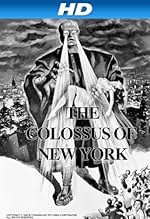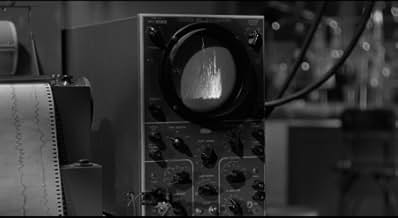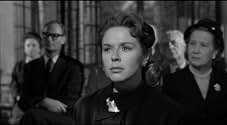CALIFICACIÓN DE IMDb
5.9/10
1.4 k
TU CALIFICACIÓN
Un brillante cirujano encierra el cerebro de su hijo muerto en un gran cuerpo robótico, con resultados imprevistos.Un brillante cirujano encierra el cerebro de su hijo muerto en un gran cuerpo robótico, con resultados imprevistos.Un brillante cirujano encierra el cerebro de su hijo muerto en un gran cuerpo robótico, con resultados imprevistos.
- Dirección
- Guionistas
- Elenco
George Douglas
- Official
- (sin créditos)
Roy Engel
- Police Inspector
- (sin créditos)
Sam Harris
- Man at Funeral Service
- (sin créditos)
Larry Kerr
- Reporter
- (sin créditos)
Harold Miller
- Airport Accident Extra
- (sin créditos)
Dick Nelson
- Charles - Chauffeur-Butler
- (sin créditos)
Foster H. Phinney
- Reporter
- (sin créditos)
Jack Richardson
- Reporter
- (sin créditos)
Court Shepard
- Reporter
- (sin créditos)
Charles Sherlock
- Airline Pilot
- (sin créditos)
Bert Stevens
- Airport Accident Extra
- (sin créditos)
- Dirección
- Guionistas
- Todo el elenco y el equipo
- Producción, taquilla y más en IMDbPro
Opiniones destacadas
Despite some clunky moments I still think the best and most eerie part of Colussus of new york is when the "dead" scientist awakes, and gradually with mounting terror, realises his brain is in the body of a robot! This scene I'm sure influenced Director Paul Verhoeven when he made "Robocop" many years later. look at the creepy visuals in this scene as we see everything from the robots P.O.V and note that its visualisation is similar to what you see on an old Television monitor. those lines spoken by his creator "you can see, you can hear, you can speak and you can move" still sends a chill down my spine. I rate this as one of the best eerie mad lab scenes in the movies.
The impressive title work is the viewer's first clue that producer William Alland and director Eugene Lourie squeezed considerable artistry and style from a shoestring budget. Look past the economic limitations; the suspenseful and imaginative story involves the death of a humanitarian genius whose father (a famous surgeon) and brother (a robotics expert) team up to keep the genius' brain alive in a robot body (well designed by ace effects artist John P. Fulton). The film's message concerns the nature of the soul and the role which physical sensations play in making humans act humane. Other affects by Fulton include one of sci-fi cinema's best death rays. All in all, a moving and intelligent movie
The conventional wisdom is that this is a mediocre movie. Yet I find it strangely affecting. A man's brain is placed in a large robotic body, but it's not the usual mad scientist bit. The scientist is a desperate father and the brain belongs to his son (Ross Martin), killed(?) in an automobile accident.
Encased in his robotic body, the son longs to see his own son. These are mad scientists with family values!
The only music in the movie is provided by a lone piano. The motivation for this decision was probably more economical than artistic but Nathan Van Cleave's score echoes the fear and melancholy that permeates the film perfectly.
Not a great film, but one every sci-fi and horror movie fan should see.
Encased in his robotic body, the son longs to see his own son. These are mad scientists with family values!
The only music in the movie is provided by a lone piano. The motivation for this decision was probably more economical than artistic but Nathan Van Cleave's score echoes the fear and melancholy that permeates the film perfectly.
Not a great film, but one every sci-fi and horror movie fan should see.
"The Colossus of New York" has aged rather well. It still evokes the same strange fascination it had back in the late 1950s, when its story and title character startled me. It was evident back then that the film was a low-budget production, and that it was not a masterpiece of fantastic cinema, but its variation of the theme of the scientist that creates a monster was interesting, and the appearance of the colossus was impressive. I have read a couple of commentaries from producer William Alland, in which he expressed that he was very unsatisfied with the results, and put all the blame on Eugène Lourié. Allan definitely did not paid too much attention to the limitations of the budget he administered –forcing to reuse shots, and the inclusion of stock footage-, of Thelma Schnee's weak script, or the negligence of Floyd Knudtson's editing. But especially, Alland overlooked John F. Warren's images, some of which are remarkable. This is also due to Lourié's background: he was originally an art director and set designer, and it shows. The lightning, compositions and camera angles are effective most of the times, and compensate for the shortcomings. Where Lourié's lack of expertise shows is in the routine camera set-ups, putting the camera (and the spectator) in the same position, in scenes that take place in the same locations, but separate in time. This somehow makes the movie unfold too cautiously, an explanation to the speed up of some shots when the colossus moves. Otherwise it is a recommended, little cult film that will stick to your memory.
Contrary to what some critics and viewers may say, THE COLOSSUS OF NEW YORK was actually quite dark and atmospheric! This was an exemplary modern-day take on the "Frankenstein's Monster" theme! The performances were well-done, the solo-piano music by Van Cleave was brilliant, and the Colossus itself was actually well created for its time. Even the climax, no matter how "cliched" by today's standard, is still poignant.
I definitely reccommend this movie! I think it deserves to be on DVD as well!
-John Cassidy
I definitely reccommend this movie! I think it deserves to be on DVD as well!
-John Cassidy
¿Sabías que…?
- TriviaThe Colossus costume was eight feet tall, weighed 160 pounds and was made from burlap, plastic, rubber and fine chicken wire. Inside, there were batteries, cables, air tanks and oxygen tubes.
- ErroresWhen Jeremy (the Colossus) crashes through the glass wall at the end of the movie, the very next scene there is a woman lying on the floor and the man to the left of her looks down at her. In the scene following, the Colossus starts shooting eye beams. The eye beam then hits the woman, now standing, and she falls to the floor, in the same position.
- Créditos curiososThe opening credits text rises out of New York harbor, as its reflection on the water sinks to the bottom of the screen.
Selecciones populares
Inicia sesión para calificar y agrega a la lista de videos para obtener recomendaciones personalizadas
- How long is The Colossus of New York?Con tecnología de Alexa
Detalles
- Fecha de lanzamiento
- País de origen
- Idioma
- También se conoce como
- Der Koloss von New York
- Locaciones de filmación
- Productora
- Ver más créditos de la compañía en IMDbPro
- Tiempo de ejecución1 hora 10 minutos
- Color
- Relación de aspecto
- 1.66 : 1
Contribuir a esta página
Sugiere una edición o agrega el contenido que falta
































